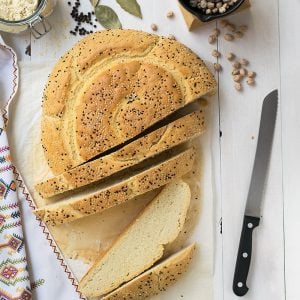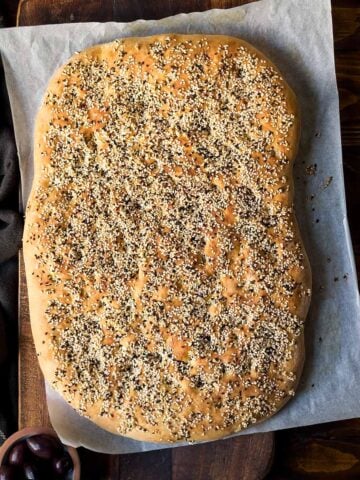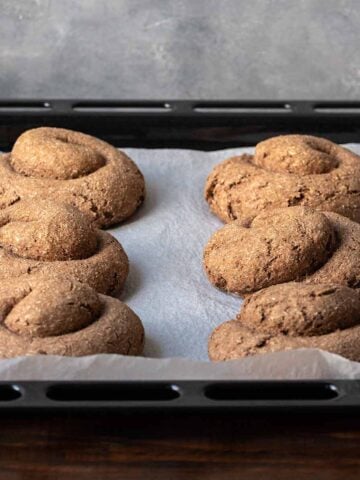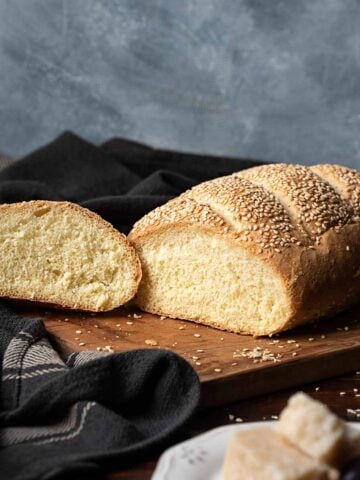This chickpea bread has no yeast, no baking powder or soda, and no sourdough starter. It rises solely with the power of bacteria found in chickpeas!

I have already told you that I love the smell of a yeasty dough while it rises and the smell of freshly baked bread.
But my favorite bread of all is this one, called “eftazimo” in Greek. This bread is utterly delicious and very aromatic, with a very fine and tender crumb. It doesn’t need any yeast, baking powder/soda, or a sourdough starter to rise, but uses a cultivation of bacteria found on chickpeas.
That’s why its real name is “aftozimo” which means “self-rising”, but over the years, and probably due to mispronunciation, it got the name “eftazimo” which means “kneaded seven times”.
So no, you don’t have to knead it seven times, but you do have to be extra careful when making it, since if you deviate even a little from the instructions it may never rise (I think this has to do with the chickpea bacteria being very sensitive to temperature changes and maybe other environmental factors).

Eftazimo bread is a Cretan traditional bread made on special occasions and religious holidays, but it can be tricky for someone who doesn’t know how to make it.
Because of its difficulty and the fact that it doesn’t require any yeast or sourdough starter, it is accompanied by many superstitions to the point that it has been called the bread of the devil!
Of course, this didn’t stop the fearless Cretan people from making it and even bringing it to church as offering on special occasions and religious holidays!
This bread also makes a very popular type of rusks, called ouzo rusks. As their name suggests, they are best eaten with finger food and seafood along with a couple shots of ouzo. If you make them, try them with this Juicy shrimp saganaki recipe 🙂

What you need to do for the recipe to be successful:
- Make sure you use spring water or any type of bottled water that is not chlorinated. If you use chlorinated water, the chickpea bacteria will die 🙁
- Use ground dried chickpeas or chickpea flour without any preservatives or pesticides. The best way to ensure this is to buy organic chickpeas/flour. Preservatives or pesticides can kill the bacteria we want.
- Use this years’ chickpeas and not older.
- Don’t use too much salt (yes, you guessed right! Too much salt can kill the chickpea bacteria).
- Make sure you have a warm place for the chickpea cultivation to develop. Either make this recipe on a very hot day or do as I do and keep the chickpea mixture and the dough inside your oven with only the oven light on. Another option is to use a carton box and a hot lamp over it as the heat source. Try to keep the ambient temperature between 86°F – 104°F (30°C – 40°C).
I'm not usually very strict when cooking, but if you want this recipe to work you must follow the above directions to the T!

First, you must mix the chickpea flour with some warm scented water (not hot) and let it rest for 10-12 hours until thick foam develops on the surface (in the above photo you can see the chickpea flour settled at the bottom, the liquid in the middle and the foam at the top).
This is the sign that the bacteria are active. If no foam has developed, wait for another 6 hours. If after six hours you have no luck, you must start over.

Then, you mix in some flour until a thick batter is formed, and let it rise until tripled in volume. Some people use only the foam and some water and flour to make the batter, but I like to use all the chickpea mixture. However, if you use coarsely ground chickpeas instead of chickpea flour, it is best to strain the mixture first.

After the batter has tripled in volume, add the rest of the ingredients and knead into a dough. Form the bread and let it rise until almost doubled in volume (it will also spread a little, but that’s normal) and bake it in a preheated oven for 45-50 minutes.
Some notes/tips:
- This bread makes the most delicious rusks. Just cut it into slices and bake them in a low oven until dry. They usually accompany ouzo and finger food.
- The smell of the chickpea mixture is very strong and you will probably find it unpleasant. This is natural, so don’t worry.
- Don’t use any yeast. It will not be eftazimo bread.

Share this post if you liked it (share buttons at the top!) and don’t forget to subscribe for new recipes or follow me on Instagram, Pinterest, Facebook
📖 Recipe

Chickpea Starter Cretan Traditional Bread (Eftazimo)
Ingredients
- 2 cups water, not chlorinated
- 4 bay leaves
- ½ teaspoon black pepper kernels
- 2 teaspoons sugar
- ½ cup chickpea flour or 1 cup coarsely ground dried chickpeas, organic
-
- 3 ½ cups bread flour (you may need some more)
- 1 ½ teaspoons (7 grams) fine salt
- 2 tablespoons olive oil
- 1 teaspoon sesame
- ½ teaspoon black sesame
Instructions
- Make the starter: Bring to a boil 2 cups of water with the bay leaves, the pepper, and the sugar. Let it cool until you can dip your finger in it for ten seconds or more. Strain, discard the bay leaves and pepper and mix 1 cup of the water with the chickpea flour (or ground chickpeas). Let it rest in a warm place for 12-16 hours until foamy. You will probably not see any action before the 10 first hours, so it is best to do this overnight.
- Add 1 ½ cups bread flour into the mixture (if using ground dried chickpeas instead fo chickpea flour, strain it first), and let it rise in a warm place until tripled in volume (about 2-4 hours).
- Make the bread: Add ½ cup of the scented water, 2 cups bread flour, the olive oil, and salt and knead until a pliable dough is formed. Make a long string and form a spiral like a snail. Or you can just put it in a loaf tin. Brush some water over the surface and sprinkle the whole sesame and the black sesame. Let it rise in a warm place until almost doubled in volume (about 2-3 hours).
- About 15 minutes before baking, preheat your oven to 365°F (185°C)
- Bake for 45-50 minutes or until done.
- Eat!
Nutrition
If you like this post, Pin it!






cakespy says
Whoa! I feel like I just gained a recipe and a cool Mr. Wizard-like lesson. I love this!
Makos says
I'm really glad! Eftazimo is a wonderful bread but unfortunately not a lot of people know about it...
Fran @ G'day Souffle' says
Bacteria from chick peas? Incredible! What an interesting recipe and I love the spiral shape of the dough!
Makos says
Thank you very much Fran!
The spiral shape is the traditional shape of this kind of bread in my region:-)
Marina says
I can't wait to try it. Thank you for the background info on this bread. You answered my question why it is called eftapsomo .. it's nice to find out a little of my kritiki heritage.
Makos says
Thank you Marina! I knew you were from Greece but didn't know about your Cretan heritage! 🙂
Steve H says
Hey. Oddly enough, found you on Google to see if anyone was mixing legumes with their sourdough mixture. I am learning and experimenting in making sourdoughs. I own a hand grinder. Grind up my own grains, legumes, and seeds and nuts and things. Was just going off of intuition and feeding the starter with wheat, some garbanzo flour, a little flax seed flour………….Has action. Figured that it has more of a nutritional quality to it? Takes on a good taste as it all is processed together. Still working with this. Some doubts arised as to whether that was a good idea or not. Am happy to see that you are doing something in the similar ballpark. Thanks
Makos says
Hi Steve!
That's interesting! Sourdough has such a complex flavor and experimenting with different flours could result to many different flavor profiles.
Just a quick note : for a real eftazimo bread, only chickpea flour should be used to develop the "yeast" ?
Oh, and maybe you can let me know sometime about your results with your current starter!
Abdelrahman A says
I want to try this recipe as a substitute for Sprouted Barley Sourdough Bread
I want to know if bay leaves are necessary in making the starter? and can I use dried bay leaves instead?
and if sugar can be substituted by molasses?
Thanks a lot for that recipe, please make a similar one for chickpea starter gluten-free muffins, I am sure it would turn out great.
Abdelrahman A says
Also, can Chickpea be sprouted first for more nutrition?
Makos says
In this recipe chickpeas are used to form a starter that will make the bread rise. I don't know if sprouted chickpeas have the bacteria needed to produce the same result 🙂
Makos says
Hi Abdelrahman,
no the bay leaves are just for flavor, so you can leave them out, or just use dried bay leaves. Also the sugar can be substituted by molasses.
I will try to schedule those muffins! Thanks 🙂
Abdelrahman A says
Hello,
I like to add, can I use Chana dal (the very small chickpea type) instead of the large chickpeas?
Chana dal has a sweeter flavor and can be used in sweet recipes much better
Makos says
I haven't tried this with this kind of chickpeas so I really can't tell.
Aga says
Hi there,
What’s the additional bread flour please? What type of flour is it?
I am allergic to grains and use chickpea flour for loads of things in my kitchen.
Makos says
Hi, unfortunately this bread is made with wheat flour. I don't think you will have the same results with any other flour
Kar says
Can I use canned or cooked chickpeas?
Makos says
Hi Kar, no cooked chickpeas don't have the live bacteria for the "yeast" to work. Only bio, good quality chickpeas will work
Joseph Zaloom says
Hi, thanks Makos for the recipe. By bread flour do you mean wheat flour? Alas, if so I will be forever denied the pleasure of the eftazimo as I am celiac. I make chickpea pasta and was looking for more recipes based on this wonderful pea of chickiness that I can eat
Makos says
Hi Joseph, yes this recipe calls for wheat flour.
I have a friend who is gluten intolerant and I have tried these GF bread recipes: https://youtu.be/P7mtZWH3hSU
and
https://youtu.be/RmYMBl2Y078
In the second recipe you probably can add some chickpea flour but you have to experiment with the quantity.
Hope that helps!
VeggieT8r says
I haven't tried this yet but was wondering if I can use this method using chickpea flour instead of wheat to make the bread, similar to Indian fermented idli?
Makos says
Hi, I don’t think so… this method uses the bacteria from chickpeas as the yeast but requires the gluten from the flour to get the right bread texture. But if you try it please let me know!
Char Covelesky says
Oops, just saw the above comments!
Sandra Frangiadakis says
Thank-you so much! I have tried to make eftazimo several times over the years and never had success, but I followed your instructions and it worked! The flavour is wonderful, but the finished loaf didn't rise much at all and is too dense and heavy. I'm not sure what to do differently. I used the proofing setting on my oven the whole time and the temperature was stayed between 80-85. The foam and the prozimi looked just like your photos.
Makos says
Hi Sandra,
Since the prozimi was alive, my only guess is that the bread needed more time to rise. This has happened to me sometimes also… so I wouldn’t put it in the oven until it is doubled in size.
Keep in mind that this is probably the most difficult bread in the world, so don’t be discouraged!